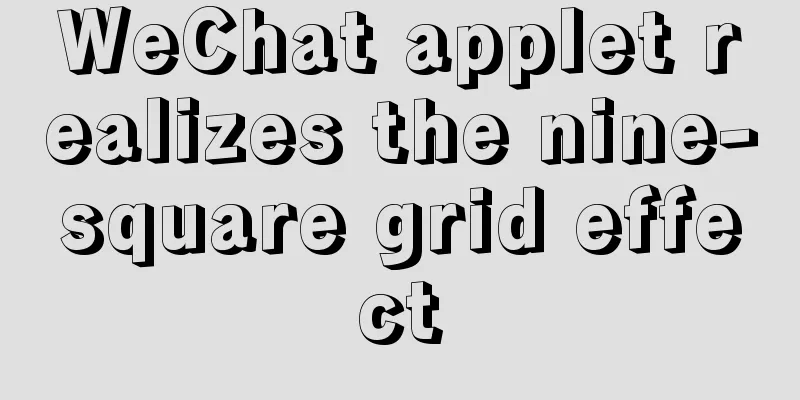Detailed explanation of Vuex overall case

|
1. IntroductionLet's take a look at a more professional introduction to Vuex:
In short, Vuex uses a global object-like form to manage the common data of all components. If you want to modify the data of this global object, you have to modify it in the way provided by Vuex (you cannot modify it in your own way at will). 2. AdvantagesThe difference between Vuex state management and using traditional global variables:
3. Usage steps1. Install Vuexnpm install vuex --save 2. Reference Vueximport Vue from 'vue' import Vuex from 'vuex' Vue.use(Vuex) 3. Create a warehouse Store To use Vuex, we need to create an instance
//Create a store
const store = new Vuex.Store({});4. Included Modules
The role of Vuex is similar to that of a global object. Vuex uses a single state tree and uses an object State to contain all the states of the entire application hierarchy. You can understand these states as a bunch of global variables and data.
1. State Suppose we have a global state
//Create a store
const store = new Vuex.Store({
//state stores the state of the application layer state:{
count:5 //Total: 5
}
});
2. Getters It can be considered that Suppose we want to derive a new state
const store = new Vuex.Store({
//state stores the state of the application layer state:{
count:5 //Total: 5
},
getters:{
newCount:state => state.count * 3
}
});
Get in component
export default {
computed: {
newCount(){
return this.$store.getters.newCount;
}
}
};
3. Mutations The only way We defined a function called Will accept
const store = new Vuex.Store({
//state stores the state of the application layer state:{
count:5 //Total: 5
},
// mutations are the only way to modify data in state mutations:{
increment(state, value) {
state.count += value;
}
}
});
When we submit
methods: {
getVal(event) {
//Get the current key value let value = event.target.dataset.value;
//Submit a mutation named increment via commit
this.$store.commit("increment", value);
}
}
Get in component
export default {
computed: {
count(){
return this.$store.state.count;
}
}
};
4. Action
export default new Vuex.Store({
//Store data state: {
obj: {},
},
//4. Handle mutations using the methods in commit mutations: {
getParam(state, Object) {
//5. Modify the data in state state.obj = Object
}
},
//2. Accept the method and parameters passed by dispatch actions: {
getParamSync(store, Object) {
// Handle asynchronous operations setTimeout(() => {
//3. Submit a mutation named getParam through commit
//The action function receives a store instance object, so you can call store.commit to commit a mutation
store.commit('getParam', Object);
}, 1000)
}
}
})
Then we can call it in the component.
methods: {
getVal() {
let name= 'xia';
let age = '26';
let sex = 'man';
//1. Pass the method getParamSync and multiple parameters {name, age, sex} to actions through dispatch
this.$store.dispatch('getParamSync',{name,age,sex})
}
}
5. Modules As the complexity of the project increases, in order to facilitate the management of Vuex, it is generally divided into different
import Vue from 'vue'
import Vuex from 'vuex'
import state from './state'
import mutations from './mutations'
import actions from './actions'
import * as getters from './getters'
import moduleA from './module/moduleA' // module A
import moduleB from './module/moduleB' // module B
Vue.use(Vuex)
export default new Vuex.Store({
actions,
getters,
state,
mutations,
modules:
moduleA,
moduleB
}
})
// Each module has its own state, mutation, action, getter, and even nested submodules export default {
state: {
text: 'moduleA'
},
getters: {},
mutations: {},
actions: {}
}
Then we can call it in the component.
<template>
<div class="demo">
<h1>{{getText1}}</h1>
<h1>{{getText2}}</h1>
</div>
</template>
computed: {
getText1(){
return this.$store.state.moduleA.text;
},
// or ...mapState({
getText2: state => state.moduleB.text;
})
}
From this we can see that the state inside the module is local and belongs only to the module itself, so it must be accessed from the outside through the corresponding module name. 5. The simplest project example of Vuex Use vuex syntax sugar 1. Storing Dataa.vue file
import { mapMutations } from "vuex"; // Import mapMutations
export default {
methods: {
...mapMutations({
// Associate changeNews with SET_NEWS in mutations changeNews: "SET_NEWS"
}),
submit(){
// Submit a mutation named changeNews and pass in the parameter val
let val = 'test news';
this.changeNews(val); // equivalent to this.$store.commit("changeNews", val);
}
}
}
2. Get datab.vue file
import { mapGetters } from "vuex"; // Import mapGetters
export default {
computed: {
// Use vuex to read data (the data in getters.js is read)
// Equivalent to this.$store.getters.news (vuex syntax sugar)
...mapGetters(["news"])
},
created() {
// Get the news data in getters console.log(this.news);
}
}
3. Store file directory structure
index.js
import Vue from 'vue'
import Vuex from 'vuex'
import state from './state'
import mutations from './mutations'
import actions from './actions'
import * as getters from './getters'
//Every time the state is modified, the log will be printed in the console
import createLogger from 'vuex/dist/logger'
Vue.use(Vuex)
const debug = process.env.NODE_ENV !== 'production'
export default new Vuex.Store({
actions,
getters,
state,
mutations,
strict: debug, // Enable strict mode when debug=true (performance loss)
plugins: debug ? [createLogger()] : []
})
state.js
const state = {
news: {}
}
export default state;
mutations.js
const mutations = {
SET_NEWS(state, val) {
state.news = val
}
}
export default mutations;
actions.js
//Asynchronous processing const actions = {
M_NEWS({ commit }, val) {
commit('SET_NEWS', val); // commit mutations }
}
export default actions;
getters.js//Usually get data through getters (this.$store.getters.news;) export const news = state => state.news // Map it out directly without doing any other processing 4. Using store Reference in
import store from './store' //vuex storage file new Vue({
el: '#app',
router,
store,
components:
App
},
template: '<App/>'
})This is the end of this article about the detailed explanation of the overall case of Vuex. For more relevant Vuex content, please search for previous articles on 123WORDPRESS.COM or continue to browse the following related articles. I hope everyone will support 123WORDPRESS.COM in the future! You may also be interested in:
|
<<: MySQL query syntax summary
>>: Configure Java development environment in Ubuntu 20.04 LTS
Recommend
Detailed explanation of how to mount remote file systems via SSH on Linux
Features of SSHFS: Based on FUSE (the best usersp...
Example code for drawing double arrows in CSS common styles
1. Multiple calls to single arrow Once a single a...
How to implement email alert in zabbix
Implemented according to the online tutorial. zab...
Share some tips on using JavaScript operators
Table of contents 1. Optional chaining operator [...
Usage and difference analysis of replace into and insert into on duplicate key update in MySQL
This article uses examples to illustrate the usag...
MySQL 8.0.19 Installation Tutorial
Download the installation package from the offici...
Discussion on Web Imitation and Plagiarism
A few months after entering the industry in 2005, ...
How to install SVN server under Linux
1. Yum installation yum install subversion 2. Con...
How much do you know about JavaScript inheritance?
Table of contents Preface The relationship betwee...
Introduction to using Unicode characters in web pages (&#,\u, etc.)
The earliest computers could only use ASCII chara...
Configuring MySQL and Squel Pro on Mac
In response to the popularity of nodejs, we have ...
Example code for implementing simple ListViews effect in html
HTML to achieve simple ListViews effect Result: c...
A brief analysis of MySQL cardinality statistics
1. What is the cardinality? Cardinality refers to...
IE8 browser will be fully compatible with Web page standards
<br />According to foreign media reports, in...
WeChat applet wxs date and time processing implementation example
Table of contents 1. Timestamp to date 2. Convert...












